The neuronal microtubule-associated protein 1B is under homeoprotein transcriptional control
- PMID: 11331364
- PMCID: PMC6762475
- DOI: 10.1523/JNEUROSCI.21-10-03350.2001
The neuronal microtubule-associated protein 1B is under homeoprotein transcriptional control
Abstract
To identify genes regulated by homeoprotein transcription factors in postnatal neurons, the DNA-binding domain (homeodomain) of Engrailed homeoprotein was internalized into rat cerebellum neurons. The internalized homeodomain (EnHD) acts as a competitive inhibitor of Engrailed and of several homeoproteins (Mainguy et al., 2000). Analysis by differential display revealed that microtubule-associated protein 1B (MAP1B) mRNA is upregulated by EnHD. This upregulation does not require protein synthesis, suggesting a direct effect of the homeodomain on MAP1B transcription. The promoter region of MAP1B was cut into several subdomains, and each subdomain was tested for its ability to bind Engrailed and EnHD and to associate with Engrailed-containing cerebellum nuclear extracts. In addition, the activity, and regulation by Engrailed, of each subdomain and of the entire promoter were evaluated in vivo by electroporation in the chick embryo neural tube. These experiments demonstrate that MAP1B promoter is regulated by Engrailed in vivo. Moreover, they show that one promoter domain that contains all ATTA homeoprotein cognate binding sites common to the rat and human genes is an essential element of this regulation. It is thus proposed that MAP1B, a cytoskeleton protein involved in neuronal growth and regeneration, is under homeoprotein transcriptional regulation.
Figures
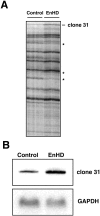

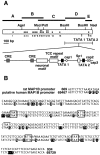
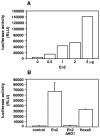
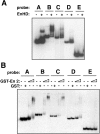
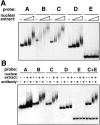
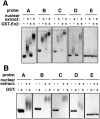
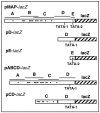
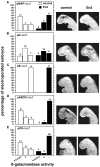
Similar articles
-
QKI binds MAP1B mRNA and enhances MAP1B expression during oligodendrocyte development.Mol Biol Cell. 2006 Oct;17(10):4179-86. doi: 10.1091/mbc.e06-04-0355. Epub 2006 Jul 19. Mol Biol Cell. 2006. PMID: 16855020 Free PMC article.
-
Joint regulation of the MAP1B promoter by HNF3beta/Foxa2 and Engrailed is the result of a highly conserved mechanism for direct interaction of homeoproteins and Fox transcription factors.Development. 2003 May;130(9):1867-76. doi: 10.1242/dev.00414. Development. 2003. PMID: 12642491
-
Regulation of epidermal bullous pemphigoid antigen 1 (BPAG1) synthesis by homeoprotein transcription factors.J Invest Dermatol. 1999 Oct;113(4):643-50. doi: 10.1046/j.1523-1747.1999.00703.x. J Invest Dermatol. 1999. PMID: 10504454
-
Engrailed homeoproteins in visual system development.Cell Mol Life Sci. 2015 Apr;72(8):1433-45. doi: 10.1007/s00018-014-1776-z. Epub 2014 Nov 29. Cell Mol Life Sci. 2015. PMID: 25432704 Free PMC article. Review.
-
The topological role of homeoproteins in the developing central nervous system.Trends Neurosci. 2007 Jun;30(6):260-7. doi: 10.1016/j.tins.2007.03.010. Epub 2007 Apr 6. Trends Neurosci. 2007. PMID: 17418905 Review.
Cited by
-
QKI binds MAP1B mRNA and enhances MAP1B expression during oligodendrocyte development.Mol Biol Cell. 2006 Oct;17(10):4179-86. doi: 10.1091/mbc.e06-04-0355. Epub 2006 Jul 19. Mol Biol Cell. 2006. PMID: 16855020 Free PMC article.
-
Expression changes of microtubule associated protein 1B in the brain of Fmr1 knockout mice.Neurosci Bull. 2007 Jul;23(4):203-8. doi: 10.1007/s12264-007-0030-1. Neurosci Bull. 2007. PMID: 17687394 Free PMC article.
-
The transcription factor Engrailed-2 guides retinal axons.Nature. 2005 Nov 3;438(7064):94-8. doi: 10.1038/nature04110. Nature. 2005. PMID: 16267555 Free PMC article.
-
CNS myelin paranodes require Nkx6-2 homeoprotein transcriptional activity for normal structure.J Neurosci. 2004 Dec 15;24(50):11215-25. doi: 10.1523/JNEUROSCI.3479-04.2004. J Neurosci. 2004. PMID: 15601927 Free PMC article.
-
A functional equivalent of endoplasmic reticulum and Golgi in axons for secretion of locally synthesized proteins.Mol Cell Neurosci. 2009 Feb;40(2):128-42. doi: 10.1016/j.mcn.2008.09.008. Epub 2008 Oct 22. Mol Cell Neurosci. 2009. PMID: 19022387 Free PMC article.
References
-
- Araki I, Nakamura H. Engrailed defines the position of dorsal di-mesencephalic boundary by repressing diencephalic fate. Development. 1999;126:5127–5135. - PubMed
-
- Beckmann AM, Matsumoto I, Wilce PA. AP-1 and Egr DNA-binding activities are increased in rat brain during ethanol withdrawal. J Neurochem. 1997;69:306–314. - PubMed
-
- Biagioni S, Ciuffini L, De Jaco A, Vignoli AL, Augusti-Tocco G. Activation of neurospecific gene expression by antennapedia homeobox peptide. Int J Dev Neurosci. 2000;18:93–99. - PubMed
-
- Biggin MD, McGinnis W. Regulation of segmentation and segmental identity by Drosophila homeoproteins: the role of DNA binding in functional activity and specificity. Development. 1997;124:4425–4433. - PubMed
Publication types
MeSH terms
Substances
LinkOut - more resources
Full Text Sources
